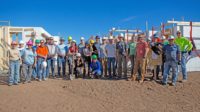Our buildings use 40 percent of all the energy produced. Take a look at any city in the U.S. and one can see a number of existing buildings, a seemingly endless inventory of inhabitable structures. Most are still occupied and functioning in their intended purpose. Some brand new—examples of our best technology. Others may be a little older or aesthetically outdated; historical reminders of a by-gone era and yet others, sitting empty waiting to be occupied again. Granted, a few in this inventory are in need of destruction and at the end of their life-cycle but a large percentage of them are still structurally sound maybe waiting for a “new outfit,” to be made pretty again.
As a society we have learned that we cannot simply blow up buildings and send them to their grave to be covered by dirt, slowly bio-degrading and returned to dust. There is a growing trend for our inner-city buildings, forgotten shopping strips in the suburbs, office complexes, warehouse structures and even our homes, to be retrofitted and/or re-occupied.
Re-using Existing Structures
The re-use or re-purposing of an existing structure is an environmentally responsible decision and is heavily promoted by our sustainable society. Our newer construction codes are requiring more energy efficient buildings, both in new and updated existing ones. One of the easiest ways to make a building energy efficient and aesthetically pleasing is to add EIFS to the exterior. When applying a new exterior cladding, EIFS is probably the most versatile, cost effective, aesthetically pleasing, energy efficient, exterior cladding available.
We are all familiar with EIFS on new construction but what is sometimes overlooked is how EIFS can work on re-purposing a building. Because EIFS is light weight, about a pound per cubic foot, and because it is adhesively applied, re-cladding an existing building is easy. There is no need to remove any existing cladding to apply the EIFS; it can be adhered right to the existing cladding (except glass). For claddings that may not be ideal for adhesive application, a metal lath can be fastened to the exterior and the EIF system adhered to that. The EIF system itself then becomes an additional insulating component providing continuous insulation, the most effective way to insulate. The most common claddings and wall structures that are re-fitted with EIFS are stucco, brick/block, concrete and even wood, like siding panels or clapboards. In most instances there is no need to add a drainage plane or secondary weather barrier because it is already in place, behind the existing code-approved cladding, and for existing concrete or CMU walls there is no code requirement for a drainage plane.
|
Turkish Delight Authors note: As you may know, I am a stickler for the correct pronunciation of the acronym EIFS: It’s pronounced “EEFS,” not “EFUS.” I have even gone as far as to say that “EFUS” is not even a word. Well my reader friends, I must humbly say that I was wrong. EFES (pronounced the same as EFUS) is a word. While searching for a foreign beer as a present for a friend, I came across a beer from Turkey called, that’s right, EFES. So know that from this day forward, when I hear the word EFES, I will not chastise, nor correct but rather will understand that you are talking about a beer, from Turkey. |
Interfacing
The interfacing with the structural details like windows, doors and flashings is easily accomplished. In most building retro-fits the windows and door will be removed and replaced with more energy efficient versions. While they are out, a contractor can use the newer liquid flashing products made by all of the EIFS manufacturers to properly flash the fenestrations. If no flashings were installed during the original construction phase, new ones can be easily installed. Of course, as with all retro-fitting, one must properly interface the new flashings and existing water-resistive barrier components. The new windows and door can then be properly sealed to the existing WRB plane and the EIFS applied. Any destruction and patching that was done to re-do the windows and doors, will be covered by the new EIFS cladding.
It is easy to change the look of a building too. Varying thicknesses of foam can add architectural details without having to add framing or structural components. Reveals and grooves can be added for further enhancement. As a former plasterer and EIFS representative, I have been involved in the re-cladding of many an existing building with EIFS. For example, my parents’ old non-insulated CMU house sprayed with a “tough, textured coating”; another, an historic university campus building clad with stucco, a commercial office complex with cracking GFRC panels and, an old military wood-clad structure painted over and over with lead based paint. In all cases, nothing was torn off, scraped or altered, and only cleaned with a water sprayer. Each structure today is still in-tact looking like the day it was re-clad with EIFS.
EIFS Gets the Job Done
When applied to existing claddings, EIFS begins to do its silent work. First it will stabilize the old cladding from the thermal temperature swings it was formerly exposed to. In the case of a stucco or GFRC cladding that might have had some cracking issues; the foam will now absorb the thermal shock, mitigating further cracking of the existing cladding. In brick or block structures where non-structural cracking in the grout joints has been present, again EIFS can mitigate further cracking. Because EIFS is a continuous layer cladding it gives the existing wall a big hug, protecting the walls and keeping the inside warm or cool. Applied over wood exteriors, EIFS forever protects the wood from further weathering or moisture absorption from inclement weather. When EIFS is applied to an existing cladding, there is no further need to regularly paint or re-seal on a regular basis. EIFS can be finished to replicate all of the existing claddings too. Yes, brick, block, stucco, metal and even wood can be replicated with EIFS.
Considering our sustainable built environment, it is no longer PC to just demolish a building “Las Vegas style” and send the parts to a dump. The structure may have the looks of a forgotten era; maybe the structure droops a little here and there but if the structure is solid, then there is value to keeping an older building. So, go ahead and use EIFS to spruce up the old gem and provide a new outfit to let the beauty shine on for a few more decades.








Report Abusive Comment